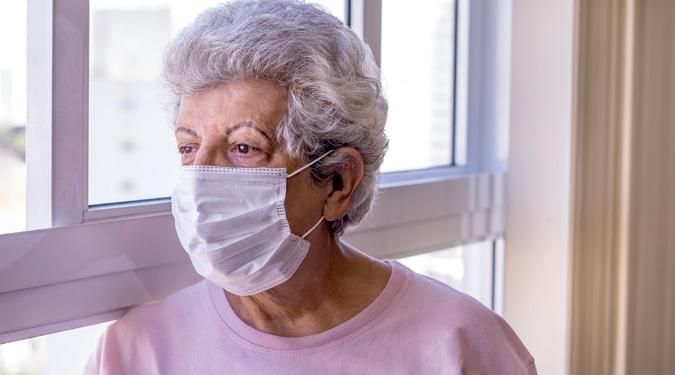
5 minute read
Law & Medicine
LAW AND MEDICINE
CONCERNS ABOUT DEATH IN LONG-TERM CARE FACILITIES
S. Sandy Sanbar, MD, PhD, JD, FCLM *
Long-term care facilities (LTCFs) is a collective term for nursing homes, skilled nursing facilities (SNF), and assisted living facilities,or residential care homes or personal care homes. There are about 15,600 nursing homes and 7,500 assisted living facilities in the U.S. 1 2.1 million people live in LTCFs., of whom 1.3 million people live in nursing homes 2 ; 80 percent are white. Every year, 1-3 million serious infections occur in LTCFs, including urinary tract infections, diarrheal diseases, antibiotic-resistant staph infections, upper respiratory infections and many more. In LTCFs, infections are a major cause of hospitalization and cause deaths of 380,000 people every year.
The COVID pandemic has obviated vulnerabilities and concerns pertaining to LTCFs.
About 81,000 elderly Americans age 65 years or older have died from COVID-19 out of a total of 110,000 deaths as of June 6, 2020. • LTCFs have accounted for 42% of the COVID-19 deaths in the U.S. • Nursing homes with a significant number of African-American and Latino residents have been twice to three times as likely to be hit by COVID-19 as those where the population is overwhelmingly white. • In May 2020, the Oklahoma State Health Department tested 35,800 at 265 LTCFs and found 3% (1,100) of the residents (714) and staff (428) were positive for COVID-19.
*Executive Director, Diplomate and Past Chairman, American Board of Legal Medicine; Vice President and Director of CME, Western Institute of Legal Medicine, California; Fellow and Past President, American College of Legal Medicine; and Adjunct Professor, Medical Education, OUHSC.
Concerns about LTCFs Building Structures: • Nursing homes often have long hallways with 40 rooms and 80 or more residents. • Residents mingle in large dining rooms and share resident rooms with mostly two occupants per room, but some have 3-4 occupants . • S ome nursing homes house hundreds of residents . • T his makes it easier to transmit from person-to-person a highly contagious disease such as COVID-19 .
L TCFs Workers: • The LTCFs workers might be inadvertently carriers of COVID-19. • T hey have had shortages of safety gear . • T hey have had difficulty securing coronavirus test kits. • S ome of the nursing home workers fell ill, alongside their patients . • S ome nursing homes have been short-staffed, disorganized facilities that lack adequate protective gear amid the pandemic . • R estricting visitor access, screening for symptoms anyone who enters, and following federal guidelines for personal protective equipment and patient isolation were delayed partly because of delayed response to COVID-19 by the government . There have been delays in receiving proper supplies, including face shields, medical-grade eye protection, masks and gowns .
LTCFs Residents Nursing home and assisted living facility residents are generally older people with underlying health conditions . Infections, such as COVID-19, prey on such people . The diagnosis and treatment of COVID-19 infections has been difficult because it is a novel virus, a lack of timely testing and lack of specialists and proper equipment in LTCFs, such as ventilators .
F uture of LTCFs • L arge nursing home populations should be divided into small, self-sufficient units with kitchens, private rooms and a dedicated staff . • “ Smaller-is-better” approach arose before COVID-19 out of concern for residents’ privacy and dignity .
C OVID-19 infections and deaths in large nursing homes indicate that the smaller-is-better approach helps with infection control as well . • P rivate rooms can make a big difference in controlling COVID-19 and keeping it at bay . A private room or even an entire ‘household’ can be closed off more easily, keeping out or confining viruses.

Staff members who are focused on a small number of residents may be more likely to pick up on warning signs that someone is sick.
T he preparation of food and laundry in a household instead of a central facility eliminates some of the way diseases can infiltrate.
Disease control should include scrutiny of air circulation and filtration when heating, ventilation and air conditioning systems are planned. Use of high-efficiency particulate air filters, commonly called HEPA filters, can trap bacteria and other particles.
Adding ultraviolet light filters are effective in killing airborne viruses.
Other considerations include easy-to-clean, nonporous surfaces; use of antimicrobial materials, like copper, for “high touch” areas like hand railings; voice - or sensor-activated controls for doors, lighting, curtains, faucets and toilets; solar and/or wind energy; battery back-up equipment; audio and video communications between residents and nursing staff; and telemedicine/telehealth equipment and trained presenters .
Some nursing home designers may install modular walls so that resident rooms can quickly be reconfigured in a crisis. During a pandemic, the virus infected patient may not be moved to an isolation area, but the room may be changed into an isolation area. Examples • P rivate rooms have made a significant difference in the ability to control the virus at Jewish Senior
Services, a four-story building for skilled nursing and assisted living in Bridgeport, Conn . 3 There are 330 residents divided into ‘households’ of 14 residents each. When somebody is diagnosed with
COVID-19, their door is closed. Signs are posted and safety gear is placed outside the door so that staff know to suit up before entering. Eight of the 23 ‘households’ had COVID-19 infections and 15 residents died. • The Green House Project 4 is a nonprofit organization that oversees 266 small-house nursing homes. Of the 243 projects that supplied data in early May 2020, eight reported having cases of Covid-19, and there were no deaths. The Department of Veterans Affairs began embracing a small-house model 5 in 2011; now, 13 of its 134 nursing homes are organized around communities of 10 to 14 residents. In these settings, only a single veteran has tested positive for COVID-19 .
The Centers for Medicare & Medicaid Services (CMS) 6 and the Centers for Disease Control and Prevention (CDC) issued Nursing Homes Guidance 7 on April 2, 2020 new recommendations to State and local governments and long-term care facilities to help mitigate the spread of COVID-19. These include, • Addressing nursing homes in different phases of
COVID-19 response; • As signing an individual to manage the facility’s infection control program; • New requirements for nursing homes to report to the
National Healthcare Safety Network (NHSN); • Creating a plan for frequent testing of residents and healthcare personnel for COVID-19; • Providing clinical staff Information; • Provide resident information; I • mplement prevention tools; and • Workers infection prevention training. Finally, the Facility Guidelines Institute 8 writes planning and design standards that are adopted in most states and by federal agencies. In May 2020, the Institute set up a task force to make recommendations for how health care facilities can cope during emergencies. A report is expected in January 2022.
THE BULLETIN
1. https://www.cdc.gov/nchs/fastats/nursing-home-care.htm 2. https://www.kff.org/other/state-indicator/number-of-nursing- facility-residents/?currentTimeframe=0&sortModel=%7B%22 colId%22:%22Location%22,%22sort%22:%22asc%22%7D 3 . https://www.jseniors.org/?utm_source=google&utm_ medium=organic&utm_campaign=gmb 4. https://www.thegreenhouseproject.org/ 5. https://www.cfm.va.gov/til/dGuide/dgSHModel.pdf 6. https://www.cms.gov/files/document/4220-covid-19- long-term-care-facility-guidance.pdf 7. https://www.cdc.gov/coronavirus/2019-ncov/hcp/long-term-care.html 8 . h ttps://fgiguidelines. o rg/










